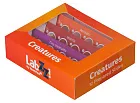Bresser Biolux NV 20x–1280x Microscope
Battery-powered biological microscope with an HD camera. Magnification, x: 20–1280
| Product ID | 70209 |
| Brand | Bresser GmbH, Germany |
| Warranty | 2 years |
| EAN | 4007922197708 |
| Package size (LxWxH) | 30x23x20 cm |
| Shipping Weight | 3 kg |
Bresser Biolux NV 20x–1280x Microscope is an excellent microscope for beginners. You can adjust the magnification from 20x to 1280x due to 3 objective lenses and 2 interchangeable eyepieces that come in the kit. This microscope features a Barlow zoom lens that allows for smooth variable magnification; maximum magnification is 1280x. The mechanical desk allows for moving the microscope samples for better observations. This microscope uses combined LED illumination for even lighting. You can observe transparent samples in transmitted light and non-transparent samples in reflected light. This microscope is powered by batteries (3x AA).
The kit includes an HD camera that allows for observing samples on the computer screen and capture images and video. The software is compatible with Windows 7, 8, and 10. Record your research and share with others. This microscope is supplied with a rich kit of accessories. It also includes 5 prepared slides and 5 blank slides and cover clips for preparing your own microscope samples.
Features:
- Battery-powered biological microscope with an HD camera
- Microscope with zoom system, magnification 20x–1280x
- LED light for transmitted and incident illumination
- HD USB camera with metal housing
- Rich accessories kit
- Durable carrying case
The kit includes:
- Microscope in a solid metal body
- Mechanical desk
- HD camera with metal housing, resolution 1280x720
- 2 eyepieces: 5x and 16x
- 3 objectives: 4x, 10x and 40x
- 2x Barlow lens
- Microscope tools
- Mechanical cross table
- 5 prepared slides
- 5 blank slides
- 3x AA batteries
- Dust cover and a hard case
| Product ID | 70209 |
| Brand | Bresser GmbH, Germany |
| Warranty | 2 years |
| EAN | 4007922197708 |
| Package size (LxWxH) | 30x23x20 cm |
| Shipping Weight | 3 kg |
| Type | biological |
| Microscope head type | monocular |
| Magnification, x | 20 — 1280 |
| Eyepieces | WF5x, WF16x, video eyepiece with 1280x720 pixels resolution (HD) |
| Objectives | 4x, 10x, 40x |
| Revolving nosepiece | for 3 objectives |
| Illumination | LED |
| Brightness adjustment | ✓ |
| Power supply | 1.5 |
| Additional | dimmable lighting and switch for incident and transmitted light |
| Application | school/educational |
| Illumination location | dual |
| Research method | bright field |
| Experiment kit included | ✓ |
| Digital camera included | ✓ |
| Barlow lens | 2x |
| Pouch/case/bag in set | case, dust cover |
| Maximum resolution | 1280x720 |
| Software, drivers | Included |
| System requirements | Windows 7/8/10, 1GB RAM, 2GHz processor, CD-ROM, USB 2.0 Port |
and downloads
We have gathered answers to the most frequently asked questions to help you sort things out
Find out why studying eyes under a microscope is entertaining; how insects’ and arachnids’ eyes differ and what the best way is to observe such an interesting specimen
Read this review to learn how to observe human hair, what different hair looks like under a microscope and what magnification is required for observations
Learn what a numerical aperture is and how to choose a suitable objective lens for your microscope here
Learn what a spider looks like under microscope, when the best time is to take photos of it, how to study it properly at magnification and more interesting facts about observing insects and arachnids
This review for beginner explorers of the micro world introduces you to the optical, illuminating and mechanical parts of a microscope and their functions
Short article about Paramecium caudatum - a microorganism that is interesting to observe through any microscope












